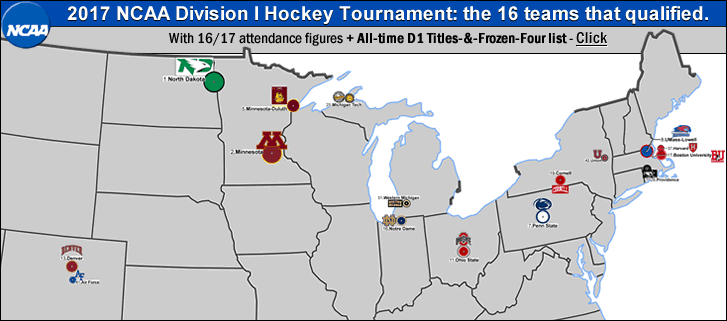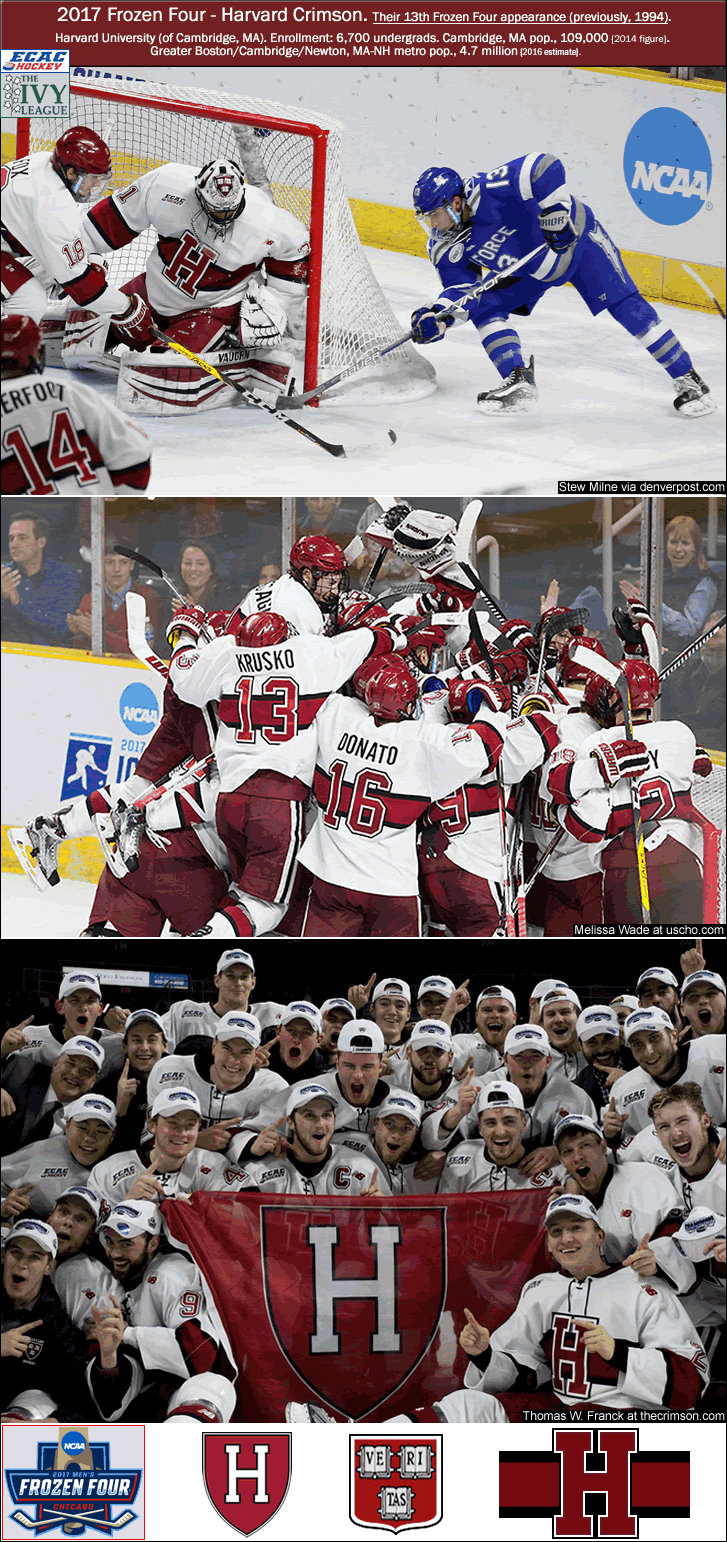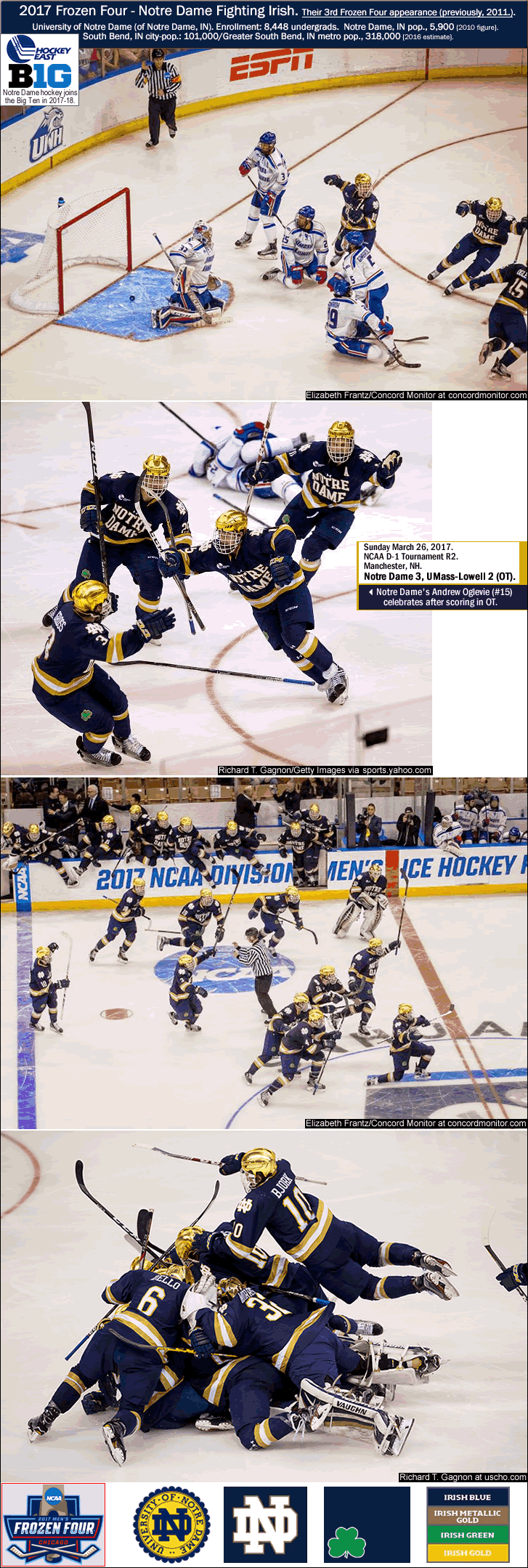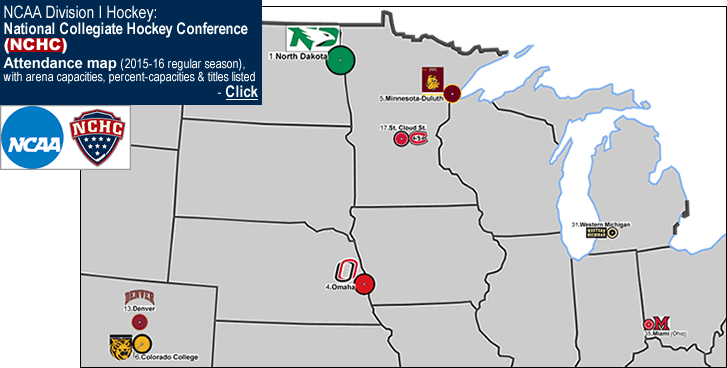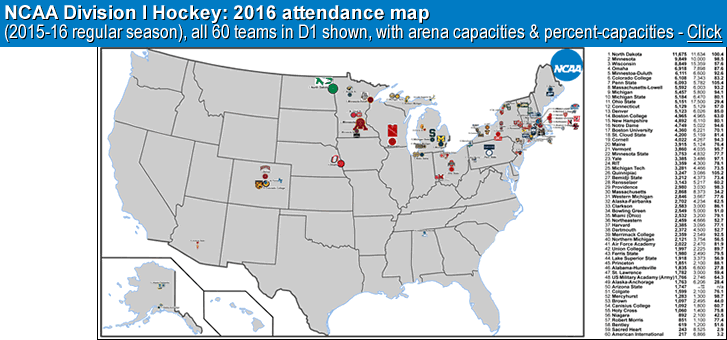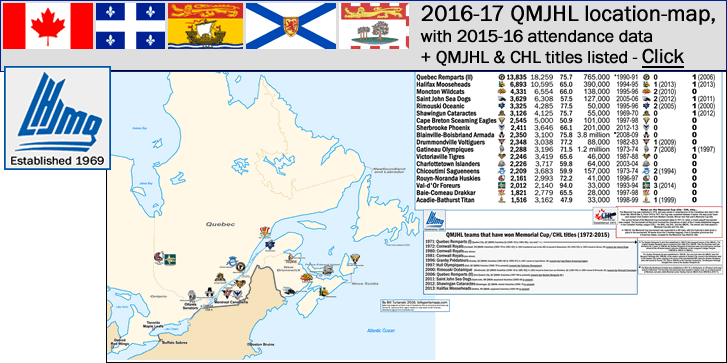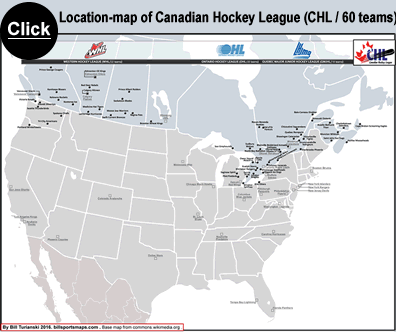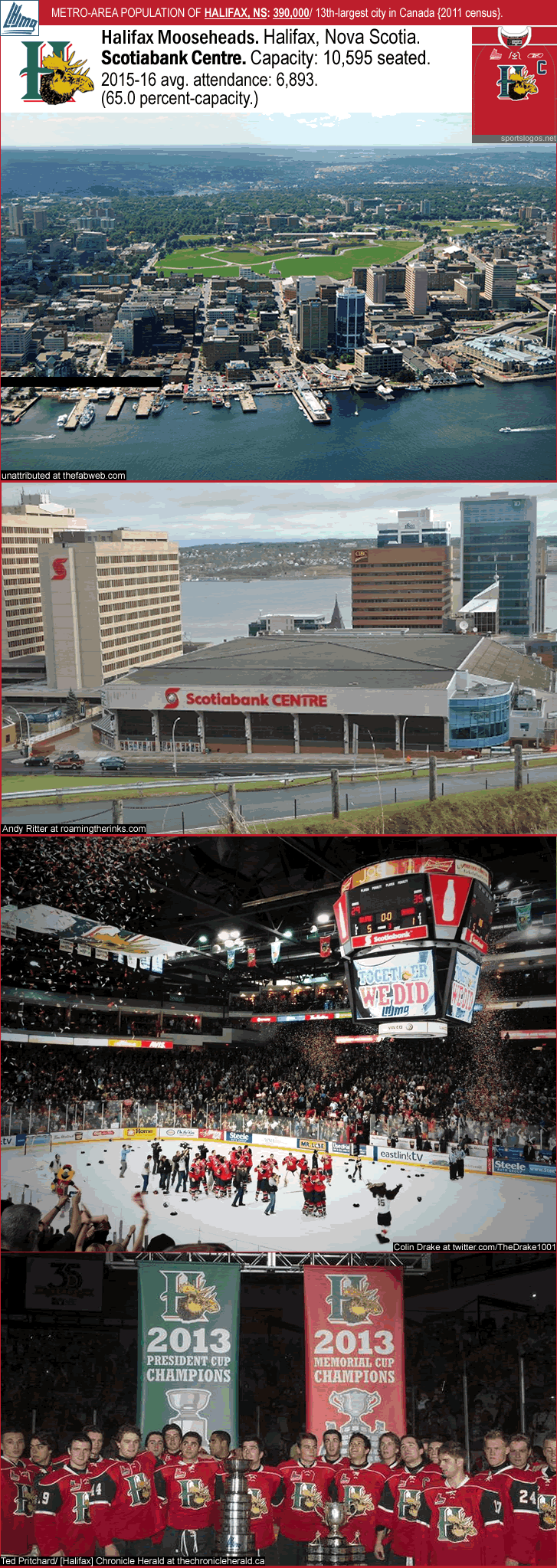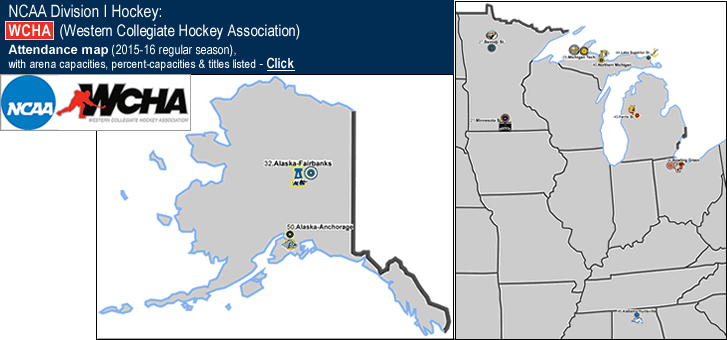
NCAA Division I Hockey: Western Collegiate Hockey Association (WCHA): attendance map (2015-16 regular season), with arena capacities, percent-capacities & D1-hockey titles listed
…
…
By Bill Turianski on 26 December 2016; twitter.com/billsportsmaps.
Links…
Conferences…Division I in ice hockey.
WCHA teams, etc…Western Collegiate Hockey Association (en.wikipedia.org).
Conference-maps for NCAA Division I (aka D1) men’s ice hockey
(Note: already-posted D1-hockey conference maps are linked-to, below.)
I am making a location-map for each of the 6 D1-hockey conferences, which are…
∙Atlantic Hockey Association (11 teams/est. 1998-99/ zero titles).
∙Big Ten Conference hockey (6 teams [7-teams in 2017-18]/est. 2013-14/ 23 titles won amongst its six teams).
∙ECAC Hockey (12 teams/est. 1961-62/ 7 titles won amongst its twelve teams).
∙Hockey East Association (12 teams [11 teams in 2017-18]/est. 1984-85/ 13 titles won amongst its twelve teams).
∙National Collegiate Hockey Conference (aka NCHC) (8 teams/est. 2013-14/ 18 titles won amongst its eight teams).
∙Western Collegiate Hockey Association (aka WCHA) (10 teams/est. 1951-52/ 8 titles won amongst its ten teams).
The location-map here shows the 10-team Western Collegiate Hockey Association (WCHA).
The WCHA has teams spread through 5 states, some of which are extremely far apart: 4 teams from Michigan (Ferris State, and 3 teams from Michigan’s Upper Peninsula: Lake Superior State, Michigan Tech, and Northern Michigan), 2 teams from Minnesota (Minnesota State [Mankato] and Bemidji State), 2 teams from Alaska (Alaska-Anchorage and Alaska-Fairbanks), 1 team from Ohio (Bowling Green), and 1 team from Alabama (Alabama-Huntsville).
The map…
The map is based on my recently-posted 60-team NCAA D1-hockey location-map {see it here}. The WCHA hockey teams’ crests, colors and arena-locations are shown on the map. Each team’s color-circle, which radiates out from their location-dot, is sized to represent average attendance…the larger the circle, the higher the team’s average attendance. Crowd-size-rank within the 60-team-D1-hockey is also noted – by the number next to the team-name on the map and on the attendance-list. (North Dakota is the highest-drawing D1-hockey team, currently.)
The chart at the right side of the map page shows attendance data. Along with average attendances of the WCHA teams (2015-16 home regular season figures), arena sizes and percent-capacities are listed. Also shown, below the attendance data, is a list showing all D1-hockey titles which have been won by teams that currently play in the conference (in this case, all titles won by teams in the WCHA). Finally, at the lower-right of the map-page is a chart showing all D1-hockey teams’ titles and Frozen Four appearances (39 of the 60 D1-hockey teams). (Michigan has the most D1-hockey titles, but the Wolverines have not won a D1-hockey title in eighteen years (last in 1998); meanwhile, with North Dakota winning the title last season (2015-16), they have moved past Denver up to second-most D1-hockey titles, with 8. The D1-hockey team with the most Frozen Four appearances is the Boston College Eagles, with 25.)
…
Division I NCAA hockey was instituted in 1948.
(Division I NCAA hockey titles, 1948 to 2015-16/ 69 titles.)
The D1-hockey realignment saw the WCHA turn from a major conference into a mid-minor…
The WCHA is extremely different from what it was before 2013 – the WCHA now has a vast (and frankly unwieldy) spread of teams: in Alaska, Alabama, Michigan, Minnesota, and Ohio {see WCHA former-members and WCHA timeline}. The WCHA was once one of the most elite D1-hockey conferences. That can be seen simply by the fact that the WCHA owns the record for the most D1-hockey titles…36 D1-hockey titles have been won by WCHA teams. But the vast majority of those titles – 27 D1-hockey titles – were won by four of the biggest D1-hockey teams, all of whom opted to leave the WCHA in 2013…Denver (with 7 D1-hockey titles won as a WCHA member), North Dakota (also with 7 D1-hockey titles won as a WCHA member), Wisconsin (with 6 D1-hockey titles won as a WCHA member), and Minnesota (with 5 D1-hockey titles won as a WCHA member). Also leaving the WCHA in 2013 were every other team that had fanbases sizable enough to draw above 4-K-per-game (Duluth, Colorado College, Nebraska-Omaha, St. Cloud). Leaving all the small schools left in the conference (Alaska-Anchorage, Bemidji State, Michigan Tech, Minnesota State, Northern Michigan). Then 5 schools, four of them refugees from the implosion of the CCHA, all ended up in the re-vamped and gutted new WCHA. All were from schools whose D1-hockey teams had fanbases which did not have the ability to draw above 3-K-per-game. (Alaska-Fairbanks, Alabama-Huntsville, Bowling Green [Ohio], Ferris State [Michigan], and Lake Superior State [Upper Peninsula of Michigan].) So the once-powerhouse WCHA was turned into a completely-small-school conference, and travel costs were guaranteed to go up, because of the unwieldy spread of the teams now in the conference.
If you want to know how that all happened, well, blame mid-major-program paranoia spiced with a dose of greed (shown by the schools that bolted to the new NCHC), combined with Penn State’s general bull-in-china-shop behavior, and Minnesota’s D1-hockey front office (who ignored the fans’ wishes to keep local rivalries) and ditto Wisconsin…in other words blame the Big East. As it says in the following article, Big Ten shaking up college hockey, just not on the ice, “The Western Collegiate Hockey Association is a shell of its former self and bleeding money since Minnesota and Wisconsin left. Six other former WCHA schools — including 2015 Frozen Four participants North Dakota and Nebraska-Omaha — left to start the National Collegiate Hockey Conference because of concerns that they would be overshadowed by the Big Ten if they stayed.” (quote from article by Eric Olson at Detroit Free Prees/ freep.com on Feb. 26 2016).
Many puck fans in the Twin Cities feel this way, as the following two articles suggest…
-Big Ten hockey is a buzzkill for fans in Minnesota – Plenty of fans aren’t buying what new hockey league is selling (by Rachel Blount at startribune.com on Feb. 26 2016).
-Breaking Up the WCHA: the NCAA’s Worst Mistake Yet (by Alexandra Werner at freshu.io on Nov. 24 2015).
The inclusion of Penn State as a D1-hockey team led to the 2011-2013-era realignment in D1-hockey. The shakeup in D1-hockey conferences occurred in much the same way (and in nearly the same time-period) as the recent realignments in NCAA D1-football and in NCAA D1-basketball. After the dust had settled in D1-hockey, there was 6 conferences instead of 5, and one conference was dissolved – the Central Collegiate Hockey Associaition (CCHA). (The CCHA existed as a D1-hockey conference from 1973-2013; five teams left the CCHA to join the WCHA in 2013-14: Northern Michigan, Alaska Fairbanks, Bowling Green, Ferris State, Lake Superior State). And another conference was, for all intents and purposes, asset-stripped: the WCHA.
The conference that ended up most diminished in stature, after the D1-hockey realignment, was the WCHA.
The WCHA ended up losing 8 teams in 2013…Colorado College, Denver, Minnesota, Minnesota-Duluth, North Dakota, Omaha, St. Cloud State, and Wisconsin. Basically all the teams that left the WCHA in 2013 were the big-title-winning teams-and-/-or-the-higher-drawing-teams…those aforementioned big-drawing/title-winning teams (Denver, Minnesota, North Dakota, and Wisconsin); an up-and-coming D1-hockey team: Minnesota-Duluth (who were D1-hockey champions in 2011, and were the 5th-highest-drawing D1-hockey team in 2015-16); and another high-drawing (though relatively new and title-less) team, Nebraska-Omaha, who are the fourth-highest-drawing team these days in D1-hockey. The sad fact of the matter is that none of the teams now in the WCHA draw higher than 3.7-K-per-game. And no current WCHA team has won the D1-hockey title in more than two decades. The most-recent D1-hockey title-winner from the present-day WCHA was Lake Superior State 22 years ago, in 1994.
And no WCHA team has made it to the Frozen Four since the 2013 realignment that gutted the WCHA. The most-recent Frozen Four team from the WCHA was the St. Cloud Huskies in 2013 (but St. Cloud is also now in the NCHC). I don’t know how you can see it otherwise: the practical upshot of the 2013 realignment is this… the big boys (Big Ten and Minnesota and Wisconsin and Penn State), got to dictate terms, and the result was that all the biggest teams bolted from two conferences (the now-defunct CCHA and the now-asset-stripped WCHA). And just left many of the small-school D1-hockey teams to twist in the wind. In a conference which makes no geographical sense, amid a realignment that makes no sense except for the big boys. A realignment that has confused the whole D1-hockey world with unanswered questions. Like, for starters, why is Air Force Academy – of Colorado Springs, CO – still in the Atlantic conference and not in the NCHC or the WCHA? Or why, exactly, should the 5 D1-hockey teams from the state of Minnesota be in THREE different conferences? Or why, exactly, should the 7 D1-hockey teams from the state of Michigan also be in THREE different conferences? Or why would you throw away a great rivalry like North Dakota versus Minnesota? I thought the whole concept of realignment meant to consolidate, not to Balkanize.
And meanwhile, Big Ten hockey teams are underperforming since the realignment.
I find it interesting that since the realignment, no Big Ten D1-hockey teams have made it to the Frozen Four (2013-14, 2014-15, 2015-16: 3-seasons/16-spots, and zero Big Ten teams in the Frozen Four). Meanwhile, by its very far-flung and patched-together and decidedly-small-school nature, the WCHA has now become doomed to near-total obscurity. And travel costs have gone up around 40% per team in the WCHA since realignment {again, see this article, Big Ten shaking up college hockey, just not on the ice}. The WCHA used to make a healthy profit for its schools; now it is deep in the red, with announced losses of over a million dollars last season {see last link}. And so many great Upper Midwest D1-hockey rivalries were abandoned. For example, most-if-not-all Minnesota hockey fans would rather see their Golden Gophers versus North Dakota or Wisconsin or Duluth (or Bemidji or St. Cloud), not versus friggin’ Penn State or Ohio State. Penn State has been a big success in D1-hockey, but do you really think that would be the case without their sugar daddy (Pegula) ?. And besides, Penn State is in an entirely different region to Minnesota, with very little cultural overlap. And the embarrassing attendances for Big Ten D1-hockey conference finals bear this out – thanks to the fact that the University of Minnesota crammed the Big Ten D1-hockey concept down the throats of lifelong and multi-generational Minnesota-college-hockey-fans, who just want to see the Gophers play their real rivals, all of whom are within an easy road-trip away. Not in Pennsyl-tucky or in the part of Ohio that only cares about college football and basketball. Don’t get me started on the viability of Ohio State as a D1-hockey power…because the vast majority of people in central and south-central Ohio do not care about hockey. At all.
Post-realignment, there has been no real practical advantage gained for the teams outside the NCHC and the Big Ten.
Sure the NCHC teams are doing OK, but that is because they all ABANDONED THE SMALL SCHOOLS. And there’s no extra television revenue or exposure for any other D1-hockey teams outside the Big Ten, because D1-hockey has no significant television footprint, while the Big Ten has its own regional, and powerful, television network. The Big Ten network has no interest in promoting D1-hockey – it only has an interest in promoting Big Ten teams. D1-hockey is a niche sport. D1-hockey is extremely tied to ticket-paying support, not to television exposure. Local rivalries are the lifeblood of niche-sports, like D1-hockey, which depends heavily on ticket-paying support. Minnesota Golden Gophers fans’ displeasure can be seen in this quote from the first article I linked to, “The actual number of tickets scanned per game also has fallen since the Gophers left the WCHA, from 8,162 in 2012-13 to 7,604 last year. Scalpers outside Mariucci [Arena] say they are getting $15 for tickets with a face value of $45, and many go unsold even at that price. The Big Ten tournament has been a disappointment, too, with attendance a fraction of the 87,295 that packed Xcel Energy Center [in St. Paul, MN] for the last WCHA tournament in 2013.” (quote from Big Ten hockey is a buzzkill for fans in Minnesota – Plenty of fans aren’t buying what new hockey league is selling – (by Rachel Blount at startribune.com on Feb. 26 2016).
So, 3 years into the realignment, because of very poor ticket sales, especially in D1-hockey conference finals these past few years, now here’s three D1-hockey conference presidents acknowledging as much: WCHA pushing to to team with Big Ten, NCHC in conference finals (by David McCoy at minnesota.cbslocal.com on March 20 2016).
How long until people start talking about the realignments that need to be made in D1-hockey to correct the Balkanized realignment of 2013?
___
Thanks to all at the following links…
-Thanks to AMK1211 for blank map of USA, ‘File:Blank US Map with borders.svg”>File:Blank US Map with borders.svg‘ (commons.wikimedia.org).
-Thanks to Two Hearted River at en.wikipedia.org/[each teams' page at Wikipedia], for small segments of jersey illustrations of several teams (Wisconsin, Minnesota-Duluth, Cornell, Maine, Minnesota State, Vermont, Yale, UMass, Western Michigan, Canisius College, American International), such as at File:ECAC-Uniform-Cornell.png.
-Thanks to USCHO site for attendance data, Men’s Division I Hockey Attendance: 2015-2016 (uscho.com).
